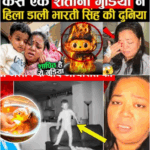Archana Tiwari found, caught with a boy? Big revelation | Archana Missing Case | Archana Tiwari
A promising young woman disappears into the night—gone without a trace—only to resurface days later in shock and silence. Such a story would seize headlines anywhere, but the disappearance of Archana Tiwari, a diligent law student from Indore aiming to become a civil judge, silenced an entire nation with concern and curiosity. Behind every detail lies more questions than answers, and behind every rumor, a deepening mystery.
Archana Tiwari hailed from a modest family in Katni district, Madhya Pradesh, where her academic brilliance and quiet determination stood out from an early age. With unwavering encouragement, her parents supported her dreams of earning a law degree and preparing for the judiciary exams. She enrolled in law college in Indore and resided in Satkar Girls Hostel, a place brimming with ambitious young women pursuing UPSC, PSC, and judicial careers.
As Raksha Bandhan approached on August 7, 2025, Archana brimmed with excitement and filial love. She packed a bag full of rakhis, gifts, clothes, and more, ready to return home to tie the sacred thread on her brother’s wrist and spend the festivities with family. Around 2:20 pm, she stepped out of the hostel—her last known sighting on CCTV, framed with a soft smile and a hopeful sparkle in her eyes. Gearing up for her return by August 17, she marked the hostel register accordingly.
Her train, the Narmada Express (number 18823), departed Indore at 4:10 pm. Archana boarded coach B3, seat three. At 10:16 pm, she spoke with her mother, assuring her she was close to Bhopal and everything was fine. Her words carried familiar warmth as she asked her father to fetch her at the station. Yet that comforting call was the last trace of normalcy. Minutes later, her phone went dark.
When the train arrived at Katni South the next morning, her family stood by the platform but found only her belongings, untouched—a bag brimming with rakhis, gifts, clothes—abandoned in the train seat. Archana herself was absent. They searched Umaria, hoping she might have stepped off there, but found no trace. The train, the belongings, the girl who held them—everything was there except Archana.

Alarm turned to urgency as GRP and SDRF teams launched exhaustive investigations. They combed the rails, pored over station CCTV footage, and scoured her mobile phone records seeking a clue. Two critical insights emerged. First, the CCTV captured her arrival at the station in a private car—not a cab, but a personal vehicle. Second, Bhopal’s Rani Kamalapati Station provided another clue: Archana had deboarded there. That was the last confirmed sighting.
Inside coach B3, fellow passengers confirmed she had been with her luggage up to Bhopal. Yet one reported that around 11:00 pm, she stood and walked toward the restroom—and never returned. A mundane detail, but one that unraveled the timeline of her disappearance. That hint, when matched with the shutdown of her mobile phone and the lack of messages or calls, suggested something more sinister than a runaway or a sudden departure.
The police traced her final mobile location near the Narmada Railway Bridge in Narmadapuram district—an isolated stretch of track, surrounded by deep water and dense forest. It was a place where accidents happen—or disappearances thrive.
While some theories suggested she might have fallen or been thrown off the train, others speculated a kidnapping. SDRF and NDRF teams intensified their search, deploying divers, boats, and floodlights across the sprawling waterway—but found nothing. Her bag, her clothes, her phone—everything remained missing; not a trace remained.
In the days that followed, the media and social networks exploded with speculation—awash in rumors of elopement, love stories, sinister plots, or even “love jihad.” The family’s pain compounded as rumors threatened to overshadow Archana’s safety. Yet there was no evidence of any such relationships in her call logs or interactions. Instead, another piece of CCTV footage from August 6 revealed that a male student, several times seen dropping her off at the hostel, had used the same car to drop her at the station the next day. A consistent link in otherwise chaotic timelines.
As investigators pursued this lead, they extracted her banking and UPI transaction records. Nothing since August 8. Her phone had gone dark on the night of August 7, and she had not used money or device—even if she had vanished willingly, one would expect some activity. Instead, silence. It seemed more likely she had been incapacitated or coerced, rather than choosing to disappear.

On August 11, a video surfaced from Papriya in Narmadapuram. A young woman—claimed to be Archana—was seen fleeing alongside a youth when confronted. The video went viral, giving fresh hope, but the visuals lacked clarity. The police could not confirm if the blurred figure was Archana. Still, it redirected the investigation.
Meanwhile, police traced the private car—registered to a young man from Indore—seen in both hostel and station footages. He had disappeared. His phone was unreachable. He was now a suspect, though without Archana’s cooperation, the case remained incomplete.
By August 14, a tip-off led police to a house near Jabalpur. Inside, investigators found two men—and no Archana. Yet among the clothing and books recovered, they suspected a female presence. Meanwhile, online wild rumors claimed she had crossed the border into Pakistan. The police swiftly dismissed them as baseless, scandalizing without evidence.
Then came Independence Day, August 15. In public, the Katni police held a press conference, assuring the nation they held “positive leads” and that Archana would be found soon. The next development would fulfill that promise.
On the night of August 17, relief washed over India when police confirmed Archana was located, safe. She emerged near the Madhya Pradesh–Chhattisgarh border, alone and deeply traumatized. Joy mingled with grief as her family cried in relief. Yet the relief intensified the mystery—because the details of her recovery seemed to rewrite everything leading up to that moment.
Her physical health was intact—no signs of injury or physical trauma—but her psychological state was fragile, shattered by fear. She told nothing, except that someone had lured her after she got off the train at Bhopal. The man whose car had linked her movements remained unnamed in her statement. She refused to file any complaint, expressing fear or perhaps a different kind of loyalty. Her silence kept the case in shadow, even as evidence mounted.
Tracing his phone, police discovered it had been active in the same region where Archana was found. The physical evidence placed them near each other—but legal proceedings require not just evidence, but testimony. Without her naming him, prosecuting any crime became more difficult, a frustrating stalemate where digital proof collided with victim reluctance.

Across social media, interpretations diverged dramatically. Some insisted she had left of her own free will—and was now protecting someone, possibly her family’s reputation. Others believed she had been trapped by a criminal network—and her fear kept her silent. The police vowed to continue, reaffirming that investigations would proceed impartially, despite divides.
Through it all, one truth remained unwavering: Archana was alive. Physically unharmed, mercifully safe, and breathing the air of home again. That this outcome came amid such a swirl of rumors, politics, and public debate was a testament to her resilience—and our collective responsibility in approaching such tragedies.
Now, as police ready a formal charge sheet and the case moves toward court, the truth may yet emerge. Perhaps Archana will find the strength to speak; perhaps the evidence will speak for her. Until then, what the nation witnessed is a painful and powerful reminder of vulnerability and compassion, how fragile safety can be—and how fiercely hope can endure.
Her story resonates far beyond Katni or Indore. It reflects the potential danger in everyday journeys, the limits of our trust in systems, and the way modern investigations collide with rumor-filled social media landscapes. It asks vital questions about victim rights, media responsibility, and community vigilance.
For now, a young woman has returned home. Her laughter may take time, but the sound of relief is unmistakable. Her case unsettles us—and that may be as it should be. When certainty fades, when truth depends on testimony, we are reminded of our role: to seek, to listen, and to support—not to rush into judgment or sensationalism.
Archana Tiwari is home. But until her voice can reclaim her narrative, her disappearance remains not just a case file, but a mirror to our society, showing both our strengths and our sensitivities when someone vanishes—and then, miraculously, comes back.
Play video :
News
Jasmin Bhasin Faced Casting Couch Director Locked Her In Hotel Room
Jasmin Bhasin Faced Casting Couch Director Locked Her In Hotel Room In a recent and disturbing revelation, popular Indian television…
Delhi CM Rekha Gupta celebrated Rakshabandhan by tying Rakhi to sanitation workers at Jan Seva Sadan
Delhi CM Rekha Gupta celebrated Rakshabandhan by tying Rakhi to sanitation workers at Jan Seva Sadan In a remarkable and…
The love of TV siblings overflowed, Raksha Bandhan fever gripped the stars, small screen stars were immersed in the celebrations!
The love of TV siblings overflowed, Raksha Bandhan fever gripped the stars, small screen stars were immersed in the celebrations!…
Starkids BEING JEALOUS of Aneet Padda for BEING AN OUTSIDER?| Ahaan BEING IGNORE by Starkids?
Starkids BEING JEALOUS of Aneet Padda for BEING AN OUTSIDER?| Ahaan BEING IGNORE by Starkids? Bollywood’s glittering landscape has always…
Soha Ali Khan celebrates Raksha Bandhan with Brother Saif Ali Khan at Pataudi Palace!
Soha Ali Khan celebrates Raksha Bandhan with Brother Saif Ali Khan at Pataudi Palace! . . . Soha Ali Khan…
Salman Khan Looks Older with Family during Celebrate Raksha Bandhan 2025
Salman Khan Looks Older with Family during Celebrate Raksha Bandhan 2025 . . . Salman Khan Celebrates Raksha Bandhan 2025…
End of content
No more pages to load












